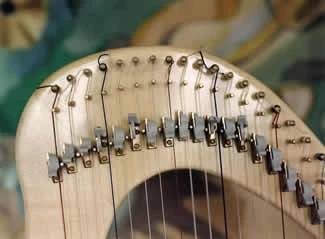
Originally “folk harps”, in contrast to orchestral instruments, were with few exceptions, restricted to the key to which the instrument was tuned. By the late 1800s they had almost disappeared from the music scene, but with the renewed interest in folk music during the 1970s and 1980s, these instruments enjoyed a renaissance. Players soon began to demand more flexibility. Unlike the orchestral harp, however, the folk harp design does not accommodate double action – that is, to easily change from flat to sharp or natural. Neck and column design restricts a change to only one half step up. Levers were the answer. Designers still dream of a double action lever, but so far no one has come up with a workable solution. It is more feasible to learn to play the cross-strung, triple-strung or double-strung if one does not wish to play a pedal harp. All are harps – but all are fundamentally different instruments.
This article summarizes those devices that are most likely to be found on modern folk harps. There are others (Caswell blades, Cunninghams, e.g.) and more no doubt being designed. Also worth mentioning is the remarkable “Dilling” harp made by Arsalaan Fay. The Arsalaan harp is single action with seven levers at the knee, one for each note of the scale.
Brough Levers[]
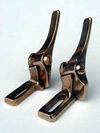
Brough Levers, Link
Designed in the 1980s by Peter Brough of Britain, these are very solid cast bronze which minimizes distortion. Notice the “offsets” in the picture which makes them easily accessible for regulation. The design – an inclined pivot on a machine screw – ingeniously uses string tension to hold the fret to the end stop. Still a very popular lever, though not as often seen in the US as in Europe. Peter makes these available to other luthiers and those that use them rave about them. They require ¼” bridge pin height – versus the more common ½” for levers such as Loveland and Truitt. The offset design and smooth action allow a player to change several simultaneously with ease.
Camac Levers[]
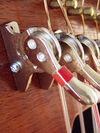
Camac Levers, Link
Introduced by Camac of France, these levers have become very popular on high-end instruments. The cam activates two fret pins that keep the string centered and aligned. Very solid, heavy body, with reportedly no tone distortion and very smooth action. Requires special tools for regulation, which may be ordered from the manufacturer or Camacs local distributor. Some players do not like the rather large look, some love them.
Delacour Levers[]
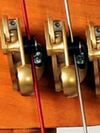
Delacour Levers, Link
A recent entrant from France, the Delacour uses two discs/pins to engage the string, similar to the discs on a pedal harp. Handle design allows one to flip several levers at once. This lever has received rave reviews from a number of well known luthiers.
Jordan Lever[]
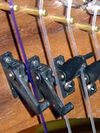
Jordan Levers, Link
Jordan levers are plastic composites marketed through Music Makers. The sharping groove is integrated into the cam and one size fits all but the fattest strings. This light weight economy lever may make the tone somewhat dull and may not be a good choice for higher tension strings, but is a sound choice for lighter instruments.
Josephus Levers[]
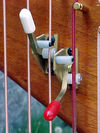
Josephus Levers, Link
These levers are usually installed on Josephus rental instruments, but may occasionally be found on used harps. Like Robinsons and Loveland levers, these work by engaging the string vertically. Designed specifically for mid and bass range strings; two frets engage the string which minimizes distortion or scraping/buzzing noise that can occur with single point action.
Loveland Lever[]
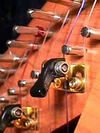
Loveland levers, Link
The Loveland is the next generation from the Robinsons and have become the “work horses” of the lever harp world ever since. The cam is a heavy plastic composite pivoting on a machine bolt with compression washers and a locking nut. Different size grooves are present for different string diameters and the cams are easily replaced. Angle and height of the string is critical on these to prevent buzzing. Fixed to the neck with a hex head machine screw (some makers use wood screws), the Loveland is found on many quality harps. The longer cam handles specially used by Dusty Strings are now a standard feature on all their levered harps.
“Mid East” Lever[]
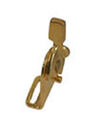
Mid-east Levers, Link
These levers are often found on harps from Pakistan. Quality control is extremely variable although it has been reported to be improving. It is probably best to avoid these, or replace them if the harp is otherwise satisfactory.
Rees Lever[]
Rees' levers are fairly new on the market; the action is similar to Truitts but with an "L" bracket like Lovelands. They are available from Robinson's Harp Shop.
They are installed on Rees and Harpsicle har
☀http://www.reesharps.com/ and also http://harpsicle-harps.com/
Robinson Lever[]
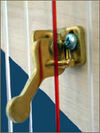
Robinson Levers, Link
One of the earliest sharping levers, the Robinson lever is still found on economy harps and is useful when the player expects to rarely encounter accidentals, merely changing keys once in awhile. Several different sized fret pins are present for different string diameters, and regulation is done by loosening a wood screw and adjusting up or down as required. The cam pivots on a rivet, which can loosen with use but can be adjusted by compressing the rivet with a hammer tap. Solid brass; the least expensive of commonly encountered lever designs.
Salvi & Salvi Performance Levers[]
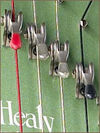
Salvi levers, Link
Typically found only on Lyon and Healy (Performance) and Salvi lever harps (Salvi lever), these work by pushing the string horizontally against a stop pin, rather than vertically, which helps to keep the string in its unstopped alignment. These levers had some early “teething problems” but are now considered a good to high-quality lever.
Teifi Levers[]
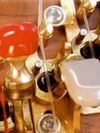
Teifi Levers, Link
Designed by Teifi Harps of Wales, one of the premier harp makers, these levers are engineered to provide a very smooth and quiet up (on) and down (off) lever action, producing an unimpaired tone. Based on the concert harp principle of double forks, the strings are not moved out of alignment when the levers are engaged and with very minimal string wear, even with frequent use. The design permits relatively easy regulation. A very solid lever body, with less of an “in your face” look than the Camacs and Delacours.
Triplett Blades[]
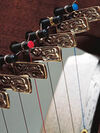
Triplett Blades, Link
These elegant carved brass blades are specifically intended for wire-strung harps with relatively thin strings in comparison to nylon or gut. Note that wire-strung harps have no bridge pins. Regulation is rarely required on such instruments, but if necessary can be done by moving the blade in or out. Conceivably these levers could be placed on nylon/gut strung harps without bridge pins and small diameter strings.
Truitt Levers[]
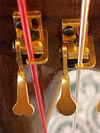
Truitt Levers, Link
Considered by many to be the “Cadillac” of vertical action levers, Truitts are easily mounted and regulated. Constructed of solid brass with gold plating, the levers include a variety of frets and stop pins for different string sizes, lengths, and compositions. The levers are held to the neck with two Torx machine screws (one in the very high treble). Little or no tone distortion is present. Some players find the handles difficult to see.
Universal Lever[]
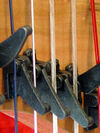
Universal Levers, Link
Cast metal version of the Jordan lever, the Universal Lever is also marketed by Music Makers. More robust than the Jordan, the Universal is a good choice for the hobby builder or to replace Robinsons on an economy harp. Levers pivot on a steel compression pin, which may need a drop of machine oil if heavily used.
Further Reading[]
- Read this article in German
References[]
Note about this article. Some of this content has been copy-pasted from Peggy Coates' website dorveille.com The website has disappeared, but the content remains on the internet archives. Attempts have been made to get in touch with the original author, but have been unfruitful. Should Peggy come across this content, please get in touch with @harpwiki! This particular article was originally written by Biagio Sancetta, but has modified slightly to fit a wiki "voice".
About the Author: Biagio Sancetta became interested in the folk harp as an adjunct to his fascination with all traditional folk crafts. After building a small harp however he became hooked and continues to research and learn about this fascinating instrument. He lives on Whidbey Island, Washington and at the time of writing (February 2013) has a neck-pillar assembly drying in the middle of his bedroom. He has heard that there is a patch a vailable for harp building addicts but feels that counseling would be more effective
